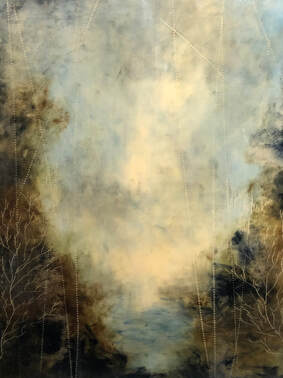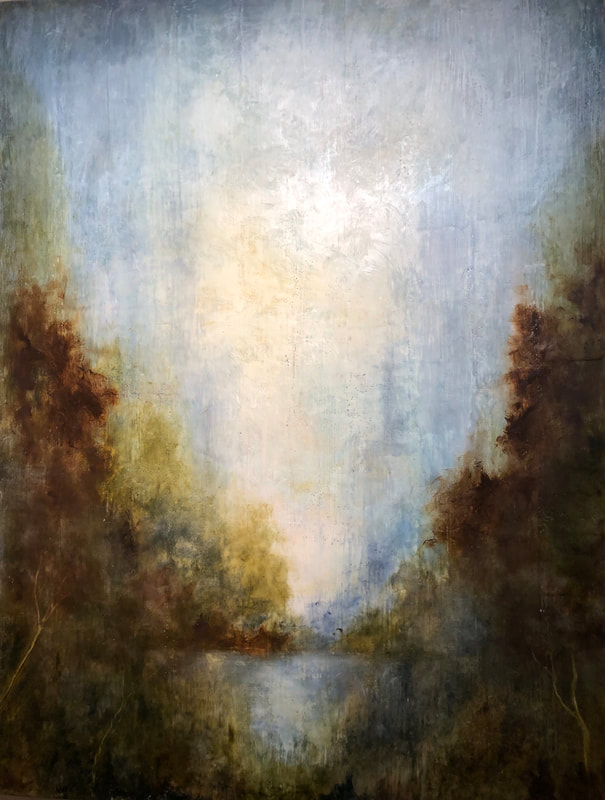“Anchors for the Ether:
Paula Blackwell’s Sublime Landscapes”
essay by Richard Speer
copyright 2021
It is impossible to describe the subject matter and settings of Paula Blackwell’s landscape paintings without using phrases that conjure drama and romance. This is an idiom of sylvan glens and gorges, ethereal atmospherics and light-play in a fairyland of Wagnerian forests that seem to extend forever. Blackwell’s encaustic and oil paintings on cradled wood panel transport us to realms we cannot quite place, though they seem to materialize fully formed out of our collective memory. Their “air of mystery and timelessness,” as arts writer Veronica Russell describes their allure, lends “a curious sense of familiarity: Where have I seen this, in a dream? An old movie?” Although the painter hails from the foggy shores of Pacifica, California, just south of San Francisco, and currently lives only 25 miles from the majestic Columbia River Gorge, her towering vistas do not scream “Northern California” or “Pacific Northwest,” rather, they whisper of terrains of the mind, in-between zones midway between waking life and dreams.
 "San Francisco Decorator Showcase", Northern California, Home & Garden, August 1990
"San Francisco Decorator Showcase", Northern California, Home & Garden, August 1990
Blackwell brings a varied background and a tenacious, upbeat character to her aesthetic pursuits. Prior to becoming a full-time artist, she did everything from assembling semiconductors in Silicon Valley to becoming involved in the San Francisco music scene to founding her own business in Portland, Oregon. A pivotal development, which channeled her toward the visual arts, was beholding the faux-finishing work done on her mother- and father-in-law’s home in preparation for the 1990 "San Francisco Decorator Showcase". An important 1919 Beaux-Arts mansion designed by architect George Applegarth and overlooking the Presidio and Golden Gate Bridge, it was a sumptuous but fusty abode until master craftspeople and artisans updated every square inch of its 6,100 square feet, replacing dated wallpapers and fixtures with painstaking terra-cotta ornamentation, Italian milk-glass chandeliers, and frescoes spilling over with cherubs and statuary, fruit baskets and flowers. (Two years later, the home was featured in the Michael Douglas/Sharon Stone film Basic Instinct.) Blackwell was deeply impressed by this transformation, especially the ways in which illusionism can recontextualize space and scale: “It was magical,” she recalls today. “After seeing that, my inner artist was ignited.”
When she moved to Oregon in 2000 she learned the ins and outs of this ancient art, became a licensed contractor, and in 2005 started a successful faux-finishing business, Faux du Jour. Eventually the firm was chosen to work with designers in the Northwest Natural Street of Dreams, the Portland equivalent of the San Francisco Designer Showcase, bringing her passion for the decorative arts full circle. A restless creative spirit loath to rest on laurels, she moved on to a new fascination in 2010, one that would prove fortuitous: encaustic painting. After encountering encaustic art and artists during the annual Portland Open Studios walking tour, she tried her hand at it with the help of a fellow encaustic painter and found she had a natural affinity. “Intuitively,” gallerist Dan Addington has written, “Blackwell realized that the medium of wax had the potential to evoke space uniquely, unlike other materials. The waxy translucency of the medium can act both as a portal and a veil, allowing us to see into the painting, yet obscuring the details and thwarting the desire for definition.”
|
Gripped by the medium’s promise and her innate ability to finesse it, she converted her garage into a studio, set up a ventilation system, and painted day and night. Collectors took notice of this gifted newcomer, and her work became very popular very quickly. Only a month after having established her home studio she sold 25 paintings in one week through One Kings Lane, the New York-based luxury home decor and furnishings store, including three to actress Jessica Biel. Her works have subsequently been featured in many film and television productions. She was invited to exhibit at the U.S. Embassy to the Holy See (Vatican City), and her work is currently installed in the U.S. Embassy in the Republic of Latvia.
Her imagery encompasses not only her signature fjords, gorges, and ravines (as in "The Expedition "and "The Calm"), but also skyscapes in which land is only hinted at (as in "Out of the Blue "and "The Escape"), as well as pure abstractions, which she describes as “lyrical and metaphorical, expressing beauty and emotion in a more imaginative, avant-garde way—engaging the eye with a more complex and playful fusion of color, shape and atmosphere.” Across this broad range of expression, her imagery steers us toward the transcendental, the mystical, the connective fibers between the personal and the cosmic. She has referred to her paintings as “spiritual landscapes,” and the phrase rings true. In the potent distillations of the earth’s grandeur she aims to lift our gazes from the quotidian into the sublime. This may explain why her paintings are suffused with the sensation of floating, of hovering above rocks, trees, and lapping waves like a consciousness without a body. Indeed, there are no bodies, no traces of human habitation in these idylls. Whatever humanity they communicate is inferred or invited, for they do beckon us to project ourselves into their untrodden expanses.
|
|
While the works have inevitably drawn comparisons to historical paintings of the Old Dutch Masters, J.M.W. Turner, and the Hudson River School, Blackwell’s closest correlate in contemporary art is probably the Nagasaki-born painter Hiro Yokose, renowned for his dreamily calmative pastorales. Nature, as Blackwell conceives it, is a conduit toward reflection and inner peace, offering everything from simple escapism from the exhaustions of urban life to spiritual edification of the highest order. In her vision, landscape promises rejuvenation and the possibility of epiphany. The columnar light emanating from the centers of works such as "Worlds Beyond" and "Deep into the Mist", often cradled within the cleavage of a chasm’s opposing slopes, is dually meteorological and metaphysical. Atmosphere and light allude to an impending encounter with the preternatural. Those tilting slopes, and the woodlands and waterways they plunge into, ground us in the face of unspeakable numinous forces. They are anchors for the ether: vanishing points where matter dematerializes, one-point perspective ends, and realms of enigma and wonderment commence.
—Richard Speer is a critic, author, and curator based in Portland, Oregon, U.S.A. His essays and reviews have appeared in ARTnews, ArtPulse, Art Papers, Visual Art Source, The Los Angeles Times, The Chicago Tribune, The Oregonian, Salon, and Newsweek. He is the author of “The Space of Effusion: Sam Francis in Japan” (Scheidegger & Spiess, 2020) and co-curator of the exhibition “Sam Francis and Japan: Emptiness Overflowing” (Los Angeles County Museunm of Art, 2023). For more information, please visit www.richardspeer.com.
—Richard Speer is a critic, author, and curator based in Portland, Oregon, U.S.A. His essays and reviews have appeared in ARTnews, ArtPulse, Art Papers, Visual Art Source, The Los Angeles Times, The Chicago Tribune, The Oregonian, Salon, and Newsweek. He is the author of “The Space of Effusion: Sam Francis in Japan” (Scheidegger & Spiess, 2020) and co-curator of the exhibition “Sam Francis and Japan: Emptiness Overflowing” (Los Angeles County Museunm of Art, 2023). For more information, please visit www.richardspeer.com.
Now Showing at:
ADDINGTON GALLERY
Chicago, IL.
http://danaddington.com/addingtongallery/blackwell/blackwell.html
PORTLAND ART MUSEUM
Rental Sales Gallery
Portland, OR
Earthworks Gallery
Yachats ,OR
River Sea Gallery
Astoria, Oregon
riverseagallery.squarespace.com
Art On the Boulevard
Vancouver, WA







